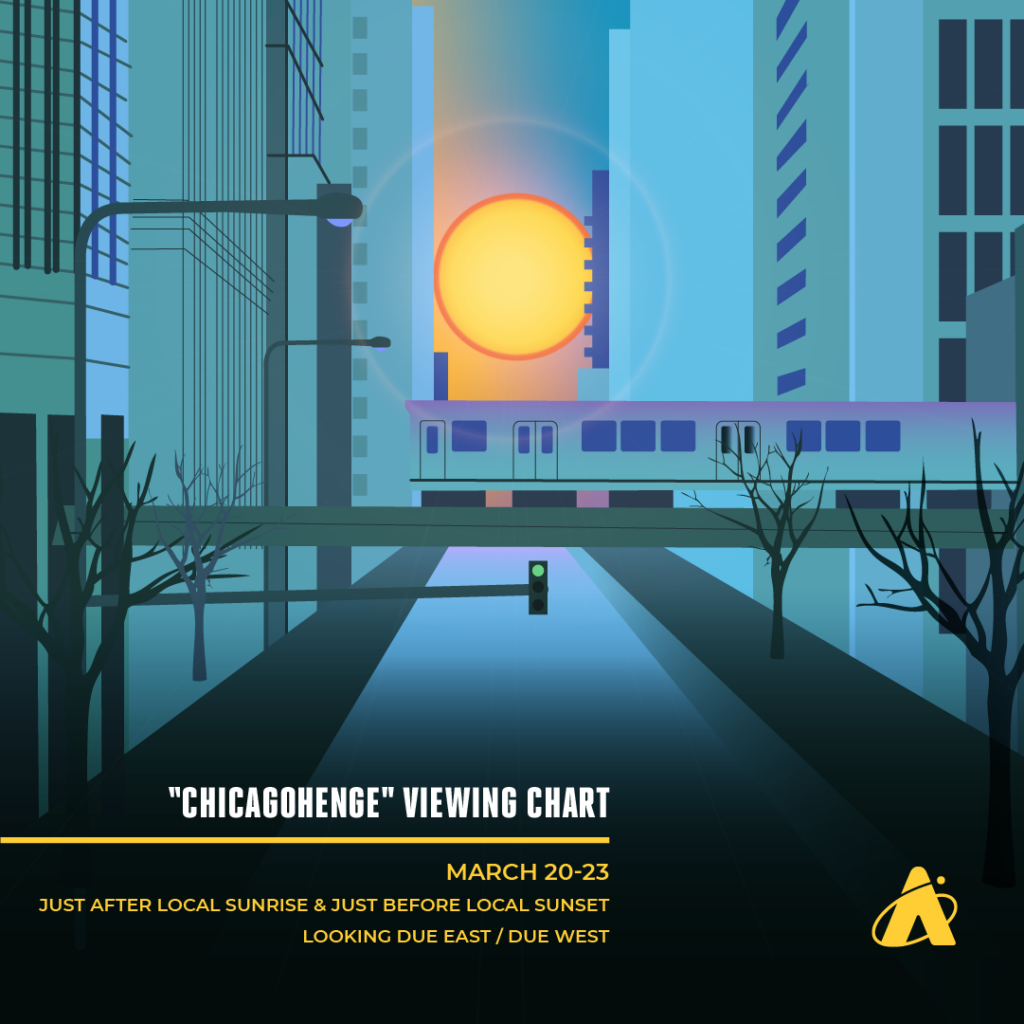How Astronomy Helps Us Understand Climate Change
Header Image: Visualization depicting a global view of the Earth’s average air temperature on April 3–7, 2025. Purple and blue areas depict cooler temperatures while red and orange depict hotter temperatures. Image courtesy of NASA’s Eyes on Earth.
As one of the world’s premiere planetariums, people expect us to talk about stars, the Big Bang, the Moon landing, and other space science topics. So folks may be a bit surprised that the Adler also talk about Earthly-matters, like climate change.
Astronomy studies patterns and behaviors of planets, whether it is a gas giant, like Jupiter, or a water world in the goldilocks zone, like Earth. Astronomy is a useful tool for studying Earth as it provides a zoomed-out, macroscopic view of the planet. It gives us a larger scale to make sense of its changes and the implications of what happens on it; for example, global climate change.
From a macro level, global climate change is one of the largest issues confronting planet Earth today. Did you know that Earth is not the only planet that deals with climate change? In fact, climate change is a natural phenomenon that planets past, present, and future face.
Greenhouse Atmospheres
Many planets—including Earth, Venus, and Mars—have greenhouse atmospheres. Greenhouse atmospheres are composed of gases that trap heat, called greenhouse gases. One very common greenhouse gas that you’ve probably heard of is carbon dioxide (CO2).
How Greenhouse Gases Work
To explain how greenhouse gases work, let’s use Earth as an example. When the Sun’s light shines onto Earth, the visible light moves through the atmosphere with ease. When the visible light hits the ground, its energy converts to heat. The warmed ground then re-emits the energy as infrared light. Unlike visible light, infrared light cannot move through the atmosphere as easily, as some of it gets absorbed by greenhouse gases. This traps the heat inside the atmosphere and warms the Earth’s surface even more. This is known as the greenhouse effect.
While every planet’s atmosphere is different, one thing remains consistent: the more greenhouse gases, the more a planet’s surface heats up.
The greenhouse effect is an important and special feature of certain atmospheres, as it controls a planet’s surface temperature. It’s precisely what allows Earth to stay warm enough for life to thrive!
Venus’s Runaway Greenhouse Effect
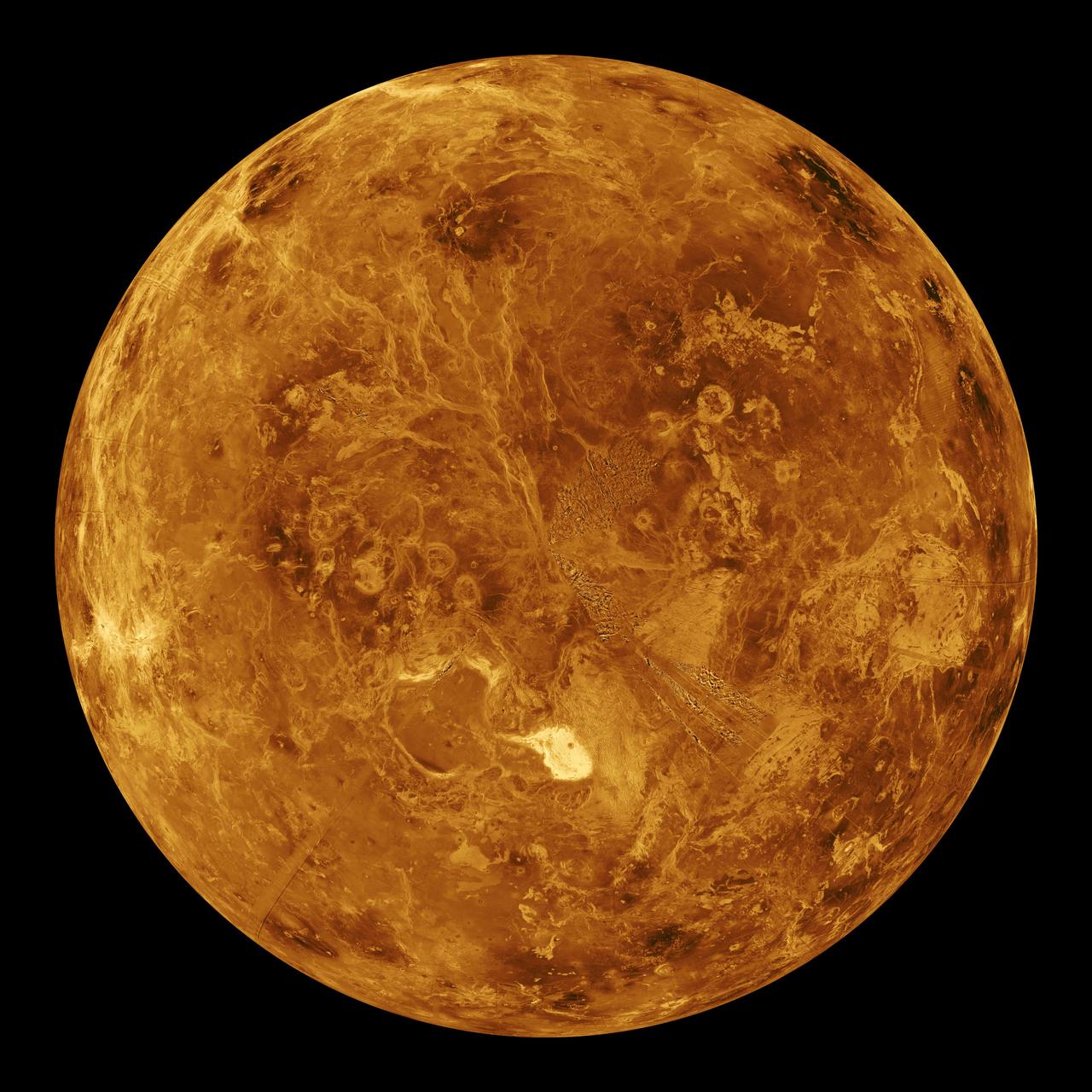
Venus is a planet that was once incredibly similar to Earth. They are of similar size, mass, and composition. Venus’s atmosphere is similar to Earth’s in that it has a greenhouse atmosphere, but is different in its composition. Earth’s natural atmosphere has less than 0.05% CO2, while Venus’s has around 96.5% CO2. Additionally, Venus’s atmosphere is around 90 times thicker than Earth’s! This means that Venus’s atmosphere has about 200,000 times as much CO2 as Earth’s.
Astronomers also believe that Venus once had liquid water. How could Venus ever support liquid water when it is now dry, hot, and inhospitable?
Due to Venus’s proximity to the Sun and atmospheric composition, its natural greenhouse effect was quite strong. As heat accumulated on its surface, Venus’s water began to evaporate. Unfortunately for Venus, water vapor is a greenhouse gas, making its—already very strong—greenhouse effect even stronger. As more water vapor accumulated in the atmosphere, it trapped more and more heat, evaporating more and more water. This is known as the runaway greenhouse effect.
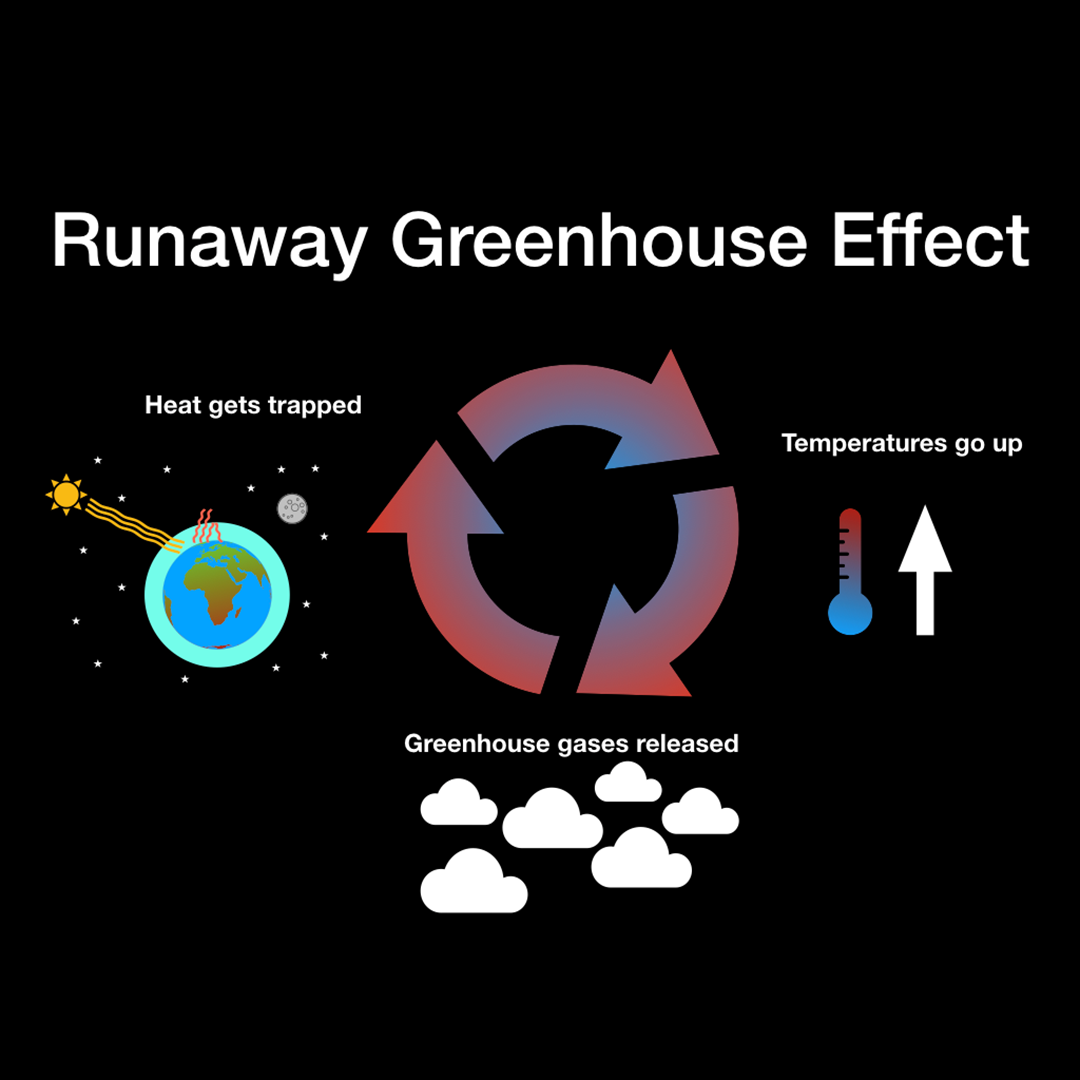
This positive feedback loop resulted in the water on Venus completely evaporating, creating the barren wasteland that we know today. The surface temperature on Venus is now around 870 degrees Fahrenheit, all thanks to its thick greenhouse atmosphere.
What Makes Climate Change On Earth Different
Planetary climate change may not be particularly unusual, but there is one thing about climate change on Earth that is astronomically unique: anthropogenic and biological contributions to greenhouse gases.
Greenhouse gases like CO2, methane, and nitrous oxide are highly efficient greenhouse gases that are released by human activities every day. These activities range from burning fossil fuels, to agriculture, to pretty much any industrial process you can think of.
So while Earth’s atmosphere is not as naturally rich with CO2 as Venus’s, more greenhouse gases, including CO2, are being added to it every day. If enough greenhouse gases enter our atmosphere, eventually, we could see a sort of “runaway” greenhouse effect here on Earth, although not to the extent of Venus’s with the Sun’s current brightness. However, in a billion years or so, as the Sun’s luminosity increases, Earth’s might be a story more similar to Venus’s.
There Is No Planet B
By studying the cosmos, it’s clear to see that there really is no alternative to Earth. While there are other Earth-like planets in our vast universe that humans could potentially inhabit, we won’t be able to get to them—at least not for a while.
Astronomers have been able to locate some good candidates, like Proxima Centauri b, but with its distance of 4.2 light years away, it’ll take over 70,000 years to get there with current space technology. So don’t expect to see colonization outside of our solar system any time soon.
Looking inside our solar system, there are theories of terraforming other planets—like Mars—to be able to support human life. But even that will take several hundreds of years in an extremely optimistic scenario, and quite frankly, if no changes are made here on Earth, we may not have that time.
How You Can Help Protect Earth From Climate Change
Human-driven climate change is a crisis we can all participate in solving. Simple actions can help reduce your carbon footprint—like eating less meat, having thoughtful purchasing habits, taking public transportation, and voting for legislation that supports the long-term health of the planet. But one of the biggest things we can do to counteract climate change is provide education for future generations.
Many folks still doubt climate change on Earth, despite scientists proving its existence and effects, time and time again. Climate change education helps inform individuals on the reality of the climate crisis and build meaningful, climate-friendly habits to allow for a more sustainable future here on Earth.
Climate Change And Me

Climate Change And Me is a brand-new field trip experience at the Adler Planetarium that works to do just this! Climate Change And Me designed to help 5th through 8th graders understand the science behind climate change and its impact on our world. Made in collaboration with NASA, students can explore the real-world impacts of global climate change and hear from scientists and young activists about how together, we can create solutions.
Even though astronomers haven’t been able to find Planet B, if we work together, there is still hope for life here on Planet A: Earth.
The Top Three Multiverse Theories: Many Worlds, Bubble Universes, And Shadow Matter
Header image: The Adler Planetarium’s fulldome sky show, Niyah and the Multiverse, which explores multiverse theories like many worlds, bubble universe, and shadow matter.
Update: This blog was originally published in 2024 and written by Geza Gyuk, the Adler Planetarium’s Senior Director of Astronomy, with an intro from Megan Lothamer. It has been updated to include relevant information for our readers.
The universe is vast, almost beyond comprehension: trillions of galaxies with billions of stars and countless planets spread out over a tapestry billions of light-years wide. It may stretch far beyond even what is visible. But if you feel small and insignificant, just wait! Even this overwhelming space may be only a tiny part of what is.
In the Adler’s new sky show, Niyah and the Multiverse, we take the viewer on a wild tour of just some of the physical theories that imply that such a multiverse might exist. These aren’t Marvel Cinematic Universe-style multiverses, so don’t expect objects and people popping in and out and between them. But they are based on honest-to-goodness real science that has real evidence backing it up. These are deep waters we are wandering into. It might get a bit confusing at times, but the trip is worth it. So let’s get right to it.
What Is Multiverse Theory?
But what is a multiverse, and does it actually exist? Or is it just the latest sci-fi trope to gain popularity in mainstream media?
Well, currently multiverse theory is… just that, a theory. Our universe may be only a fraction of a much larger multiverse, an assemblage of universes dizzying in its extent.
As it stands, the multiverse exists outside our current scientific understanding of reality. Theoretical physics suggests a multiverse is a hypothetical grouping of multiple universes. This means that our Universe could be just one tiny universe in a much larger multiverse where many, possibly even infinite universes, are contained, existing parallel to each other. These distinct universes within the multiverse theory are called parallel universes.
Continue reading to learn about three of the most popular multiverse theories featured in Niyah and the Multiverse.
Many Worlds Multiverse Theory
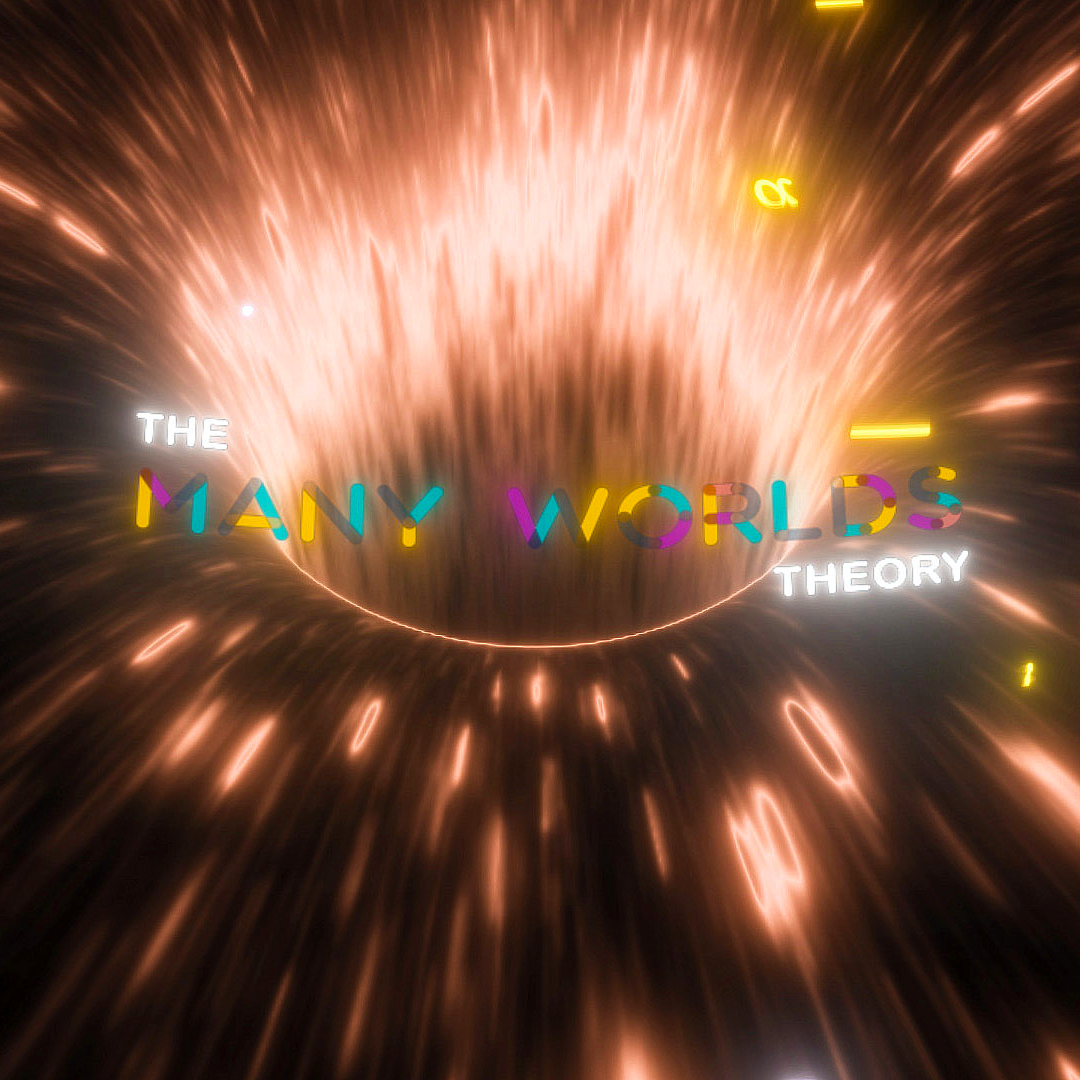
The first multiverse idea that Niyah explores is the “Many Worlds” interpretation of quantum theory.
When you are doing science, one of the most fundamental things you learn is how to go back and forth from the physical real world to the equations that describe the real world. It is basically the same thing as doing a word problem in math class. You have something happening in the real world and you have to figure out how to describe it in math and physics language. The mathematical description is called a “model.” You can use the laws of physics to predict how the mathematical “model” will change in the future, and then use the changes to the model to figure out what the real world will look like in the future. It is a powerful tool and is the basis of science.
If you do this process with the equations of quantum theory, you get something really, really puzzling. Imagine that you take an electron at a particular position, then model it in the equations and let time progress. You’d expect that the equations would tell you that the electron has moved to a particular other position. But they don’t!
Instead, the equations say that the electron could be in an infinite number of possible positions, each with a different “amplitude.” The standard interpretation of this is that the “amplitude” tells you the probability of the electron being in each location, but that it is really in only one of those locations. But this interpretation isn’t really based on any physics; it isn’t what the equations “say.” The most straightforward interpretation is that we were wrong to think of an electron as something that could ever be in any single place. One way to think of this is that there are actually many versions of reality, “many worlds,” and the “amplitude” tells us what fraction of the universes in the multiverse have the electron in that particular location.
Now quantum theory is one of the most precisely tested theories of physics. It makes predictions that are almost embarrassingly accurate and have been tested over and over again with exquisite precision. So this isn’t some wild-eyed conspiracy theory! And neither is it simply something crazy that happens in the realm of the ultra-small. The rules of physics still apply even for macroscopic objects.

The physicist Erwin Schrödinger envisioned a thought experiment that made this very dramatically clear. Imagine, he said, a cat inside a box. The box is completely opaque. Inside the box is a device that monitors a single particle. If the particle does one thing the cat is killed, if it does another the cat is allowed to live. So the state of the cat is tied directly to the state of a single subatomic particle. If we wait and come back to the box, what can we say about the cat without looking into the box? Is it alive or dead? According to our current understanding of quantum theory, the answer is both! We have to take the Many Worlds interpretation seriously no matter how strange and hard it is to wrap our heads around.
Bubble Universes Multiverse Theory
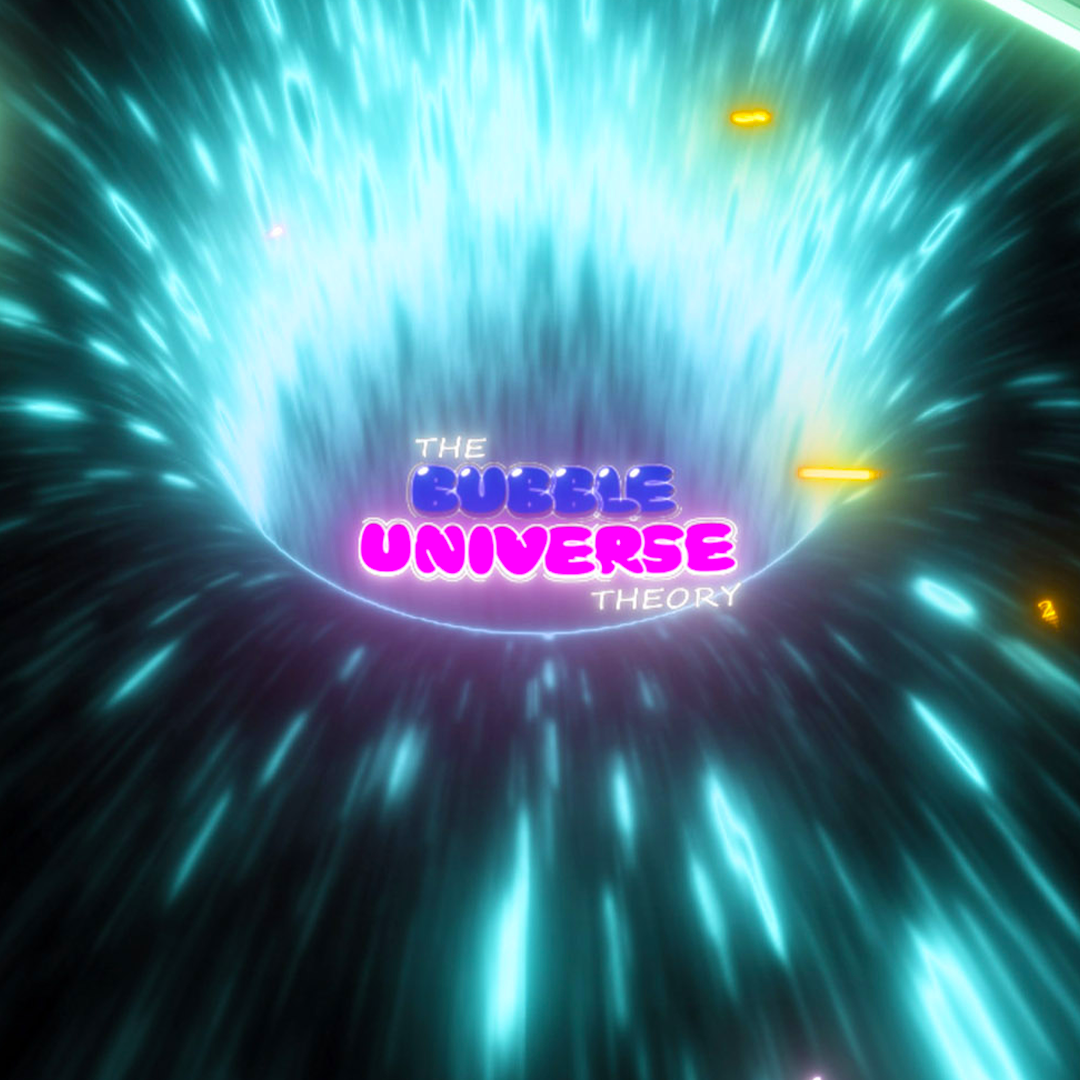
So at this point you are probably wondering if it can get any weirder. Well, hold on to your hat! The next potential multiverse theory Niyah explores is based on the physics of the very, very early universe right back during the big bang.
In the first trillionth of a trillionth of a second of its existence, the universe was expanding exceedingly quickly. Stupendously quickly. Even mind-bogglingly quickly! And it was very, very hot—exceedingly hot. Stupendously hot. Dare I say it? Mind-bogglingly hot!
It turns out that this exceedingly quick expansion rate, called “inflation,” may be the natural state of the universe. If it is, then the true state of the universe is to expand so quickly that it doubles in size many trillions of times every second. So much real-estate! It is only when the universe is able to break out of its “inflationary” stage that it can cool down to become “normal” space and expand much more slowly.
But even if 99.99 percent of the universe stops inflating and becomes “normal” space, the remaining 0.01 percent will, within a tiny fraction of a trillionth of a second, expand so much that it will be far bigger than the rest of the “normal” universe. The region of “normal” space (that was, until a tiny fraction of a trillionth of a second ago, almost the entire universe), would be reduced to a tiny bubble within a vast sea of expansion. And this process can repeat over and over again, with countless bubbles of “normal” space forming within an indescribably vast expanse of inflationary space. These bubbles are huge universes themselves, small only in comparison to everything else. According to this theory, our universe is just one of these bubbles.
And what is even more incredible, is that in the process of cooling down from the insanely hot temperatures at which inflation takes place, the universe can change its fundamental laws. Different bubble universes might have different laws of physics. In one, light might not exist as we know it. In another, the familiar particles like the electron might not exist or be subtly changed.
Even as you read this, the multiverse has increased in size by trillions of times, and countless universes with varying laws of nature have been born. How’s that for mind-boggling?
Shadow Matter Multiverse Theory
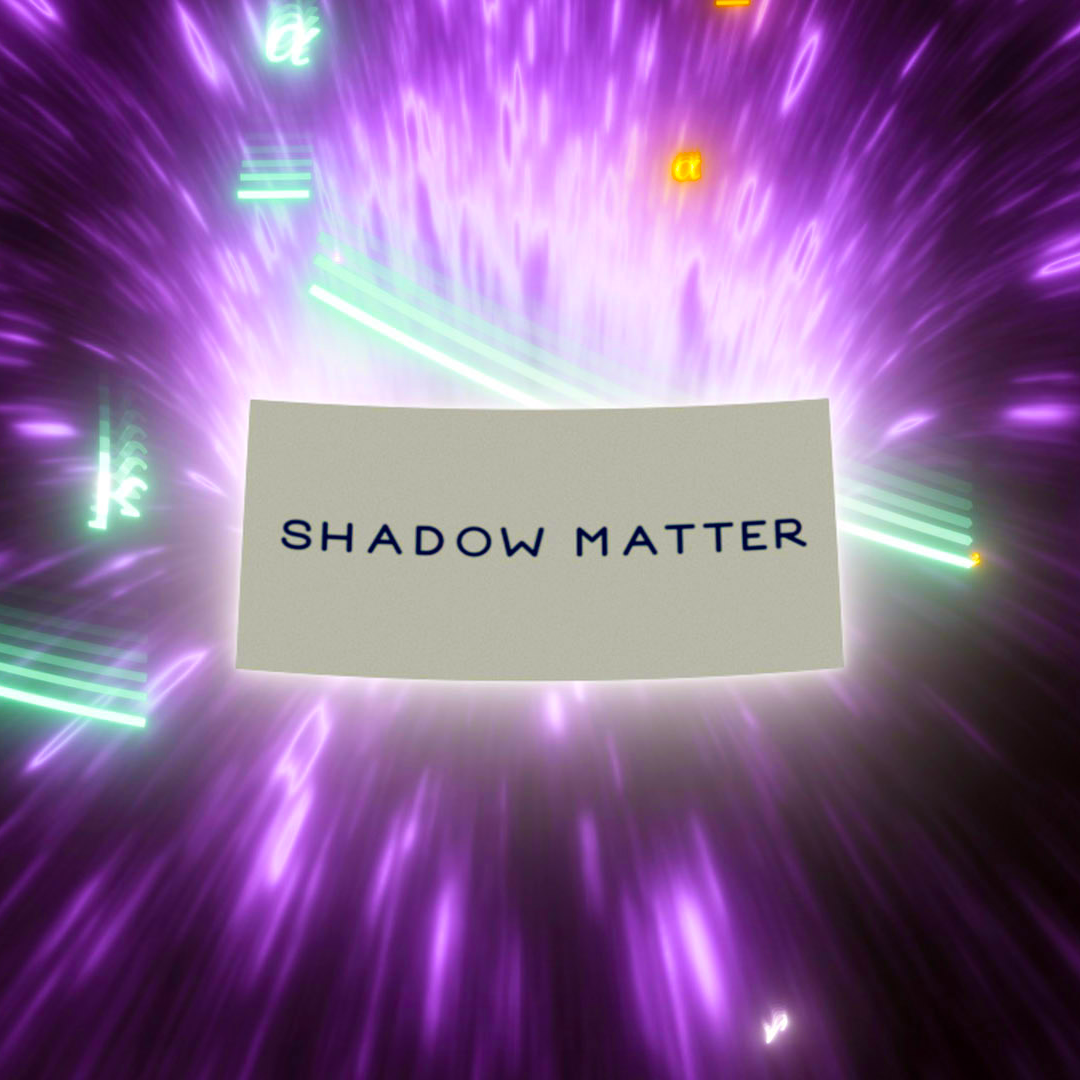
In the third chapter of Niyah’s adventures, she briefly considers the concept of shadow matter.
You may have heard of dark matter. Dark matter is the substance that provides the vast majority (more than 80 percent) of the matter in the universe. We can’t see it, and it doesn’t seem to interact with the normal matter in the universe except through gravity. But we know it is there by the way its gravity tugs around what we can see. For decades, astronomers have wondered what dark matter could be and have come up with many many theories to explain it. One theory suggests that at least some dark matter might be something called shadow or mirror matter.
So what is mirror matter? Well, perhaps you have heard of electrons, protons and neutrons. It turns out that protons and neutrons can be broken down into smaller particles called “up” and “down” quarks. Along with the (electron) neutrino, the up and down quark and the electron make up the first “generation” of normal matter. Pretty much just those four elementary particles make up everything we see in the universe.
But oddly enough, we have discovered that there are two more generations of particles! They don’t seem to have any “use,” but they exist. When the first of these were discovered, the Nobel Prize-winning physicist I.I. Rabi joked, “who ordered that?”
The second generation consists of the “charm” and “strange” quarks, the muon, and the muon neutrino. Matter made up of these particles would be called strange matter, but we don’t see any of it around in normal circumstances. The third generation includes the “top” and “bottom” quarks and the tau and tau neutrino—exotic particles that require massive particle accelerators to create.
The three generations are like copies of each other, but each a little bit different. These 12 particles, along with a few others like the photon, make up the “standard model” of particle physics.
But if there are extra copies of the first generation of particles just lying around, maybe there could be extra copies of the whole set of 12 particles? Sort of like a mirror image of the usual set! Some versions of string theory suggest exactly this. We don’t know if this is the case for sure, but it is possible! And if these extra particles exist, then they might have exactly the same properties as normal matter, just without the ability to interact with normal matter—only themselves.
Shadow and mirror matter would be a form of matter that is just like our own regular matter, except unseeable and undetectable (other than by gravity). So it could form shadow galaxies and shadow stars and maybe even shadow planets and shadow life. Anything that normal matter could do, shadow matter could also do. But the two types of matter simply wouldn’t interact with each other. We could never see it. Even if it were right in our own neighborhood.
Learn More In Niyah And The Multiverse!
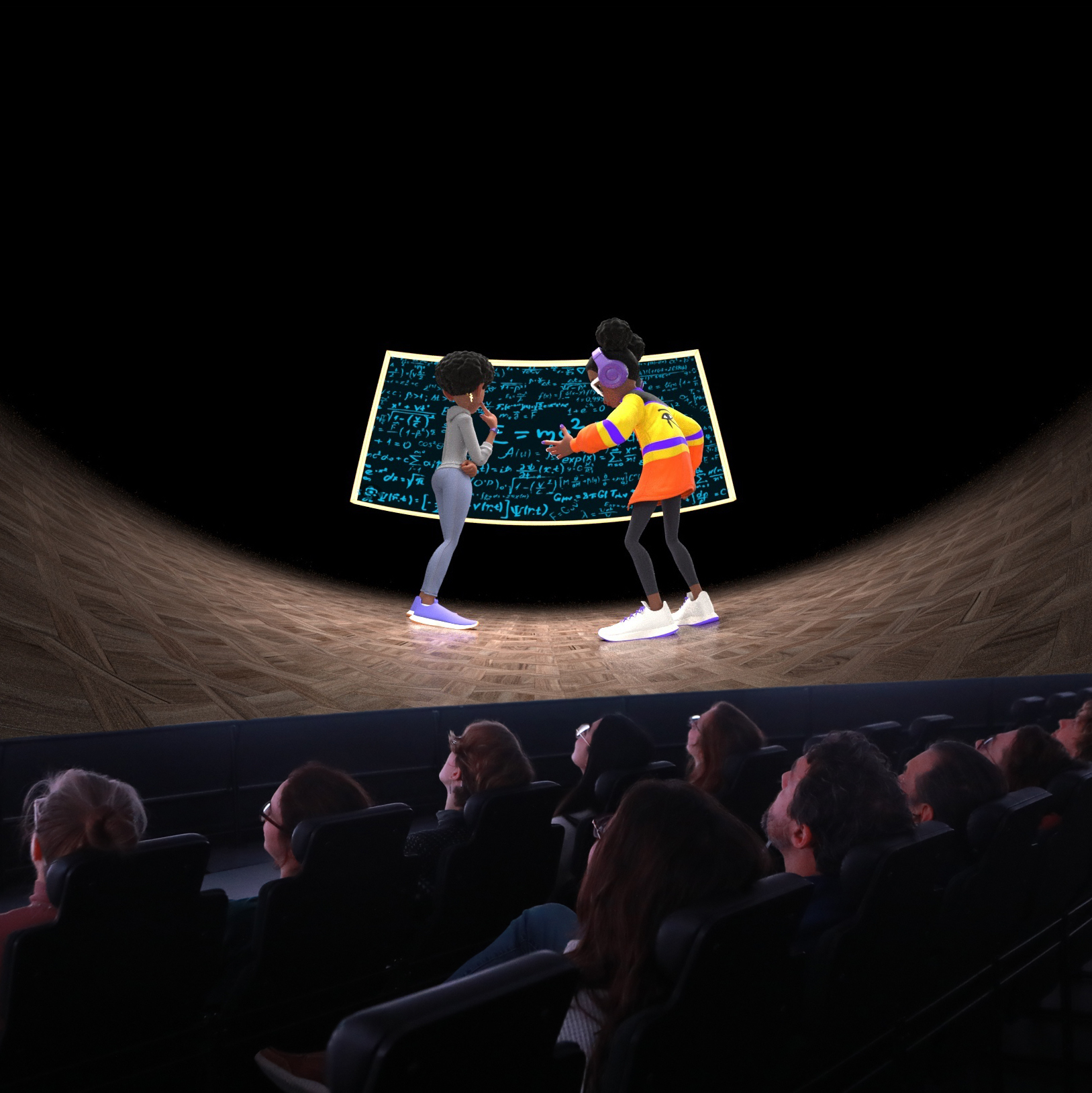
Now that we’ve emerged on the other end of multiverse theory with our minds properly boggled, come see these theories in action in our fulldome planetarium show, Niyah and the Multiverse! Explore multiverse theory with Niyah, a curious Chicago pre-teen, as her imagination guides her through the possibilities of other worlds.
You can watch Niyah and the Multiverse along with six other immersive sky shows currently playing at Chicago’s Adler Planetarium. Purchase tickets for your next space adventure and sky shows here.
So, is the multiverse real? Which theory is right? We’ll leave it up to you to decide.
Adler Skywatch: April 2025
Image caption: The stars Deneb, Vega, and Altair in the constellations Cygnus, Lyra, Aquila make up the “Summer Triangle,” which is visible in April, 2025. Image credit: Stellarium Web
The Sun becomes more prominent this month, but there’s still plenty to see in the night sky during April, 2025.
At the start of the month, the Sun is above the horizon for nearly 13 hours; and it’s more than 50 degrees high in the south at its highest. But it rises a little earlier and sets a little later each day. By month’s end, the Sun is up for slightly more than 14 hours, and it gets higher than 60 degrees up in the southern sky at midday.
Bright Stars In The Sky This April 2025
Though the Sun is in the sky longer each day this month, night-sky fans still have some good viewing opportunities. During April evenings, look toward the southwest for a last glimpse of wintertime’s bright stars Sirius, Rigel, Betelgeuse, Procyon, and Aldebaran. The star Sirius—in the Canis Major constellation—is the brightest and one of the lowest in the sky. About 25 degrees up from Sirius is Procyon, in the constellation Canis Minor.
From Sirius, look about 20 degrees to the right and slightly down to see Rigel, of the Orion constellation. About 20 degrees up from Rigel is the second-brightest star in Orion, Betelgeuse.
Then, if you draw an imaginary line from Sirius roughly through Orion’s three star belt, and continue further about the same distance, you’ll find Aldebaran, the brightest star in the constellation Taurus the Bull.
All these stars are low in the southwestern sky before 9:00 pm Central Daylight time early in the month. Later in the month, these bright stars start to set in the west-southwest during early-evening twilight, around 7:30 pm, so catch them while you can!
Visible Planets In April
Remnants of the “Planet Parade” that took place earlier this year also appear in the early-evening sky this month.
How To See Jupiter
The bright planet Jupiter is inside the constellation Taurus, about 50 degrees high in the west early in the month. It gets gradually lower in the sky each night—by the end of April, it’s only about 30 degrees high in the west-northwest. At about minus-2 magnitude this month, Jupiter far outshines the stars around it. The evenings of April 2, April 29 and April 30, it appears near a very slim waxing crescent Moon. Jupiter sets in the west-northwest, after midnight early in the month, and around 11:00 pm at the end of the month.
Where Is Mars?

This month, the planet Mars appears not far from the “twin stars” Pollux and Castor, in the Gemini constellation. During evening twilight, it’s about 70 degrees high in the southern sky at the start of the month, and sinks down to about 60 degrees high in the southwest sky by the end of the month.
At slightly brighter than first-magnitude, Mars is still brighter than either Pollux or Castor, but not by much. The night of April 5 into the early-morning darkness of April 6, Mars is near a waxing gibbous Moon. The red planet sets in the west-northwest around 3:00 am early in the month and shortly after 2:00 am by month’s end.
Can I See Mercury, Venus, Or Saturn?
The planets Mercury, Venus, and Saturn are clustered near the rising Sun this month making them nearly impossible to safely observe. Neptune is also in this cluster, but Neptune can never be seen without magnification, even under perfectly dark conditions.
Early in the month, the only planet in the group that may be visible is Venus. Due to its extreme brightness, Venus is often bright enough to be seen in morning twilight. Mercury and Saturn are comparatively faint and appear closer to the Sun than Venus this month, meaning they are likely to be invisible in dawn’s glare.
The Summer Triangle
In the early-morning darkness—after Jupiter, Mars, and the wintertime stars have set—the Summer Triangle starts to rise in the east-northeastern sky. The bright stars Vega in Lyra, Altair in Aquila, and Deneb in Cygnus, form a neat triangle about 20 degrees high and nearly 40 degrees long. At zero-magnitude, Vega is the brightest of the three stars. It’s also good to know the location of Vega, since it’s not far from the radiant point of the annual Lyrid meteor shower.
The 2025 Lyrid Meteor Shower
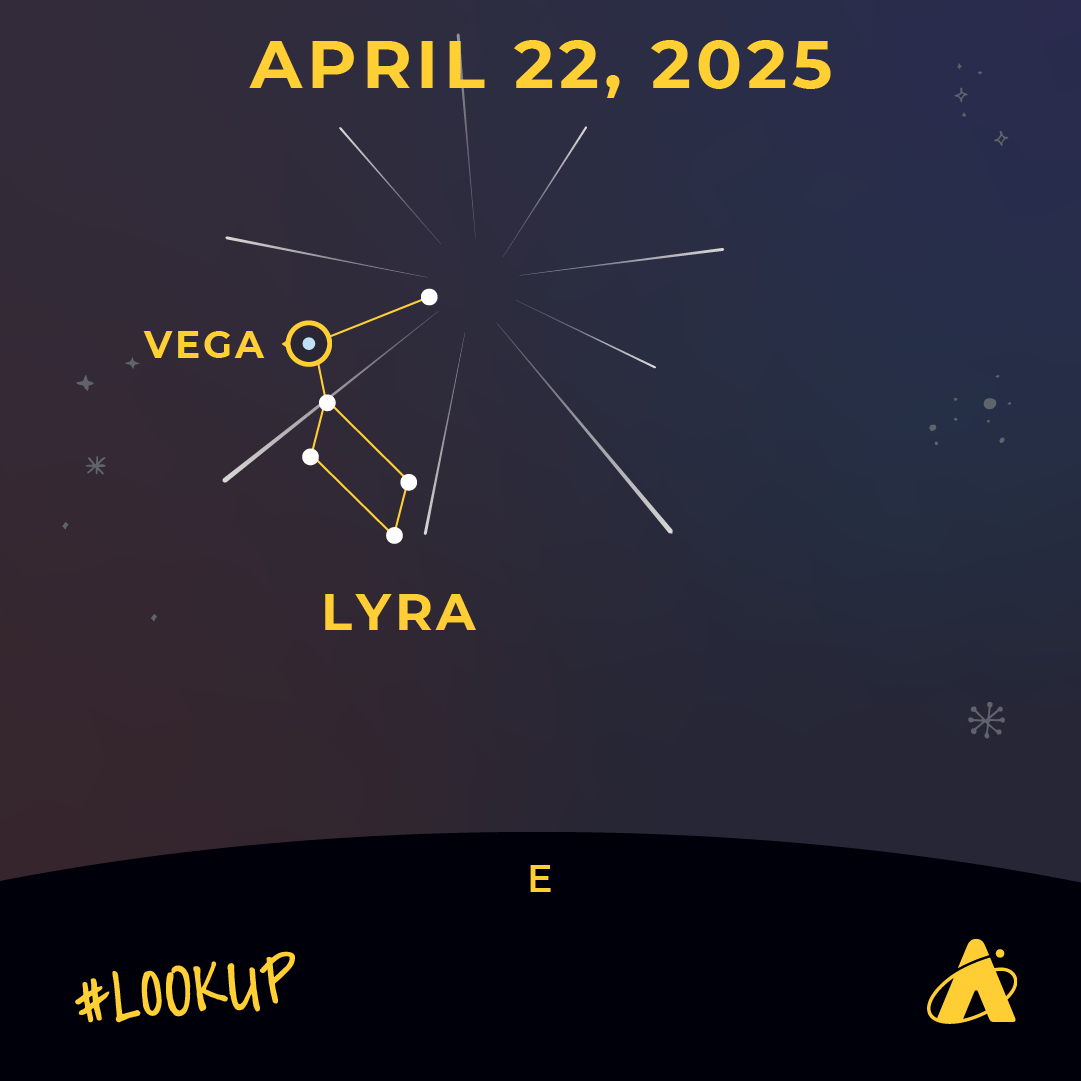
This year the Lyrids are forecast to peak in the late-afternoon of April 22, so try looking for meteors from the night of April 21 to before the Moon rises (around 3:00 am) in the early-morning darkness of April 22. Under very clear, very dark skies, about 10 to 15 meteors are expected. However, the Lyrids are known to have occasional meteor surges that could sporadically boost that count. Plus, about a quarter of Lyrids leave long trails of gas that glow for a few seconds after the meteor has passed, making this a good opportunity to see “shooting stars.”
Moon Phases In April 2025
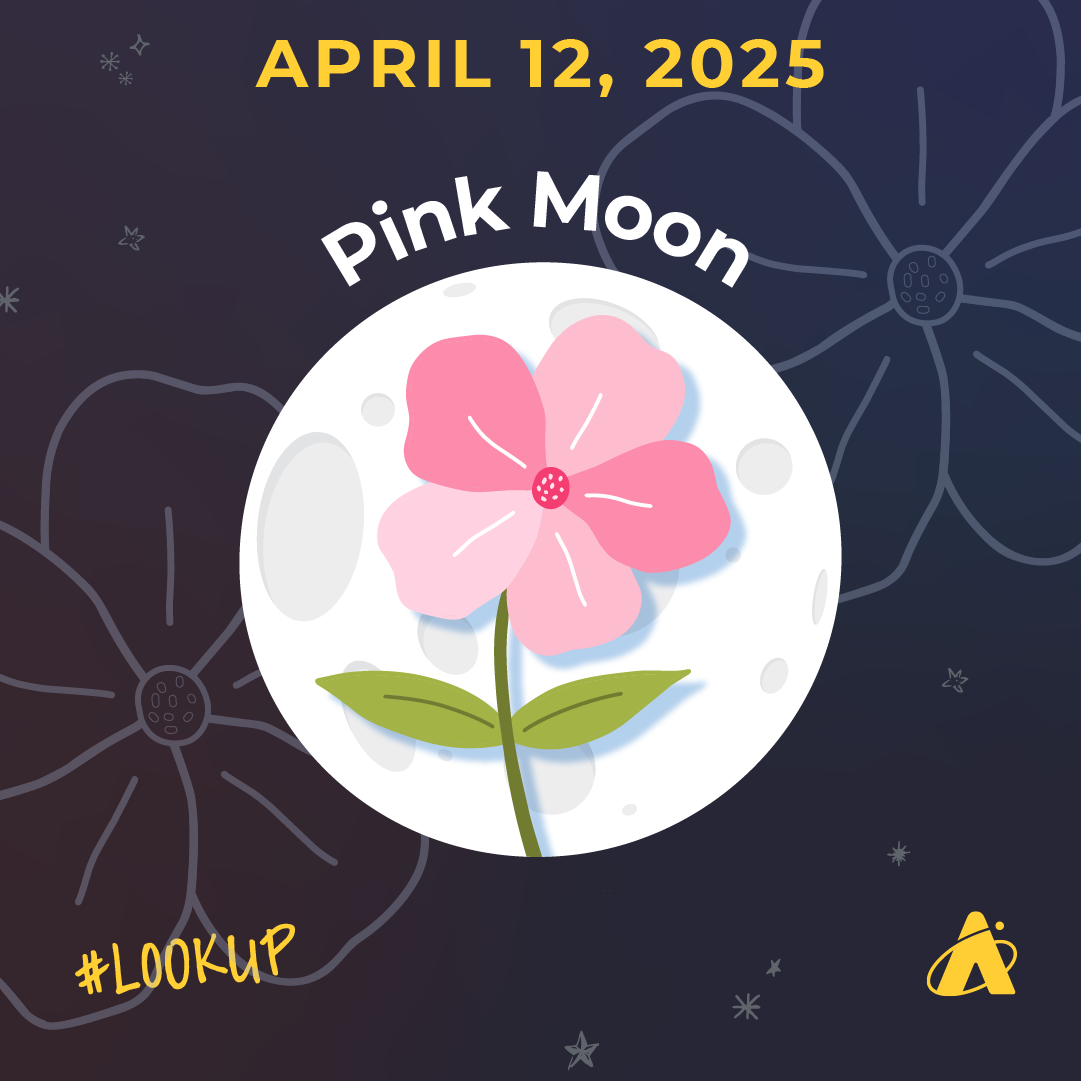
First Quarter Moon: April 4
Full Moon: April 12, nicknamed the pink Moon
Last Quarter Moon: April 20
New Moon: April 27
Please note: these descriptions are for the Chicago area, using Central time.
Subscribe To Skywatch Wednesday This April
Tour the sky with the Adler Planetarium’s Theaters Manager, Nick, in Skywatch Wednesday. Nick uses cutting edge visualizations, NASA images, and astrophotography to show you what you can see in the night sky throughout the year.
Check out Nick’s latest episode for your guide to spring stargazing and details about last month’s total lunar eclipse!
Learn From Our Astronomy Educators
Watch recaps of Sky Observers Hangout livestreams this April! Learn how to observe upcoming cosmic happenings, enhance your astrophotography skills, and see celestial objects through a telescope virtually with our astronomy educators.
In the latest episode, Michelle and Hunter observe and discuss the March 2025 total lunar eclipse, answering all our viewers’s most pressing questions!
How To Identify Planets In The Night Sky
Update: This blog was originally published in 2020 and written by Megan Lothamer. It has been updated to include relevant information for our readers.
Have you ever looked up at the night sky and wondered if a particularly bright star was actually a planet? It can be tricky business, but with some helpful tools to equip you, you’ll be identifying planets in the night sky in no time! Follow this guide to figure out if what you’re looking at is a planet or a star.
6 Questions To Ask To Identify Planets In The Night Sky
Before we get started, we’re going to assume two things: first, that you’re not looking at the night sky with a telescope but rather with the naked eye, and second, that you’re in a place where your view isn’t blocked by large buildings, really tall trees, or anything else that would hinder your view.
What Planets Are Visible By the Naked Eye?
The first step to identifying visible planets is to know which planets are possible to see without a telescope. Mercury, Venus, Mars, Jupiter, and Saturn are the five brightest planets in our night sky and, therefore, observable by most people. Of this list, Mercury can be the hardest one to spot…it is the closest planet to the Sun and is never seen too far from the Sun, so its low altitude and the glare of the rising or setting Sun can make it hard to pick out.
Are Planets Visible At The Same Time Each Year?
In short, no. It is important to note that while we can see the brightest planets fairly regularly, there isn’t a single time in every year that is best for a particular planet. Planets move around the Sun at different rates and the Earth moves around the Sun, so the combination of these movements means we see planets in the night sky at different times each year.
What Do Planets Look Like?
The easiest way to pick out visible planets is to remember this quick rule of thumb: stars twinkle and planets don’t. Seen with the naked eye, planets and stars both appear as pinpoints of light.
When you observe a star, you’ll notice that it twinkles and the light may appear to change colors. Planets don’t appear to twinkle much at all. Why the difference? Stars are MUCH farther away from us than planets, so the beam of light from a star is affected more by passing through our atmosphere than the beam of light from a much closer planet. Our air is the cause of twinkling. If you were out in space, neither planets or stars would twinkle at all!
Do Planets Always Look the Same?
Not exactly. Depending on how far a planet is from the Earth, it might look brighter or dimmer in the sky as compared to another time. The change in brightness for Jupiter and Saturn, for example, isn’t a huge amount. They are far enough from Earth that if we are a little closer or farther away, it doesn’t affect their brightness all that much. Mars, on the other hand, can look quite different from one year to the next.
How close the planet is to the horizon also has a huge effect on how bright it appears. When a planet is high above the horizon, you are looking through less air to see it. When a planet is closer to the horizon, you are looking through more air, and so the planet will appear dimmer than when it was higher up in the sky.
Planets are also different colors! Mercury is white-ish in color and Venus is bright white. Mars is a rust-orange color. (We know, it’s called the red planet—what can we say? It’s orange.) Jupiter is a light tan color and Saturn is a yellow-ish tan color.
How To Know Which Planets Are Visible Tonight
Now that you can identify planets that are visible and what they might look like, you’ll need to know which planets are visible tonight in your night sky. As previously mentioned, this will vary throughout the year and from year to year. It’s also important to note that you may not necessarily be able to see all five planets at the same time or in one night.
To get started, you can enlist the help of one of the following online resources that help you know what’s visible in your sky tonight.
Using the resources above, you can plug in the date you’ll be observing as well as your location to get a list of which planets are visible in your area, at what times, and their location in the sky.
I Know What Planet(s) I Can View Tonight—But How Do I Know Where To Look?
Let’s use an example from timeanddate.com to explore how we can use the information provided to us to find the planet we’re looking for. Here are the basics of our observing information:
Date of Sky Observing: 3/7/25
Location: Chicago, IL, USA
According to our date and location, we have the opportunity to see planets at the following times:
Mercury: Until Friday 7:23 pm
Venus: Until Friday 7:54 pm
Mars: Until Saturday 3:49 am
Jupiter: Until Saturday 1:00 am
Saturn: Until Saturday 6:00 pm
Due to the planetary parade that happened through the beginning of March 2025, all the examples above include “until” for our planet’s visibility. In other examples, you would see both the terms “from” and “until.” To really understand these listings, you have to take the time of the rising and setting of the Sun into account for this specific location.
March 7, 2025, was a Friday. This listing assumes the reader is viewing the information on that day. Until Saturday 6:00 pm for Saturn means that the planet rose at 6:32 am on Saturday, March 8. Sunrise was at about 6:15 am that day, so for practical purposes, Saturn wasn’t visible because it was lost in the glare of the rising Sun.
Until Saturday 3:49 am for Mars means that it rose at about 12:21 pm. Sunset was at about 5:48 pm, so Mars was visible after sunset until 3:49 am on Saturday—local weather permitting, of course!
We’re now going to focus on the planet Venus. According to Time and Date, for this particular date and this location, it was best to view Venus after sunset until around the time Venus set, which was a little after 7:54 pm local time. As visibility improved and the sunset glare faded, Venus would have been quite bright.
Let’s pretend we wanted to look for Venus around 6:30 pm that night. The sky chart below shows where in the sky Venus was throughout March 7, 2025, and specifically at 6:32 pm, as denoted by the yellow circle and orange dotted line:

Imagine the whole sky as you see it as a dome with its edges resting on the horizon. This dome will help us find the altitude coordinate, which is the angle the planet makes with the horizon. The horizon line is 0° and the sky straight above your head is 90°. This point above you is called the zenith. (Note that altitude numbers can be negative. If you see a negative number for a particular time and date, that means that the planet will be below the horizon line from your location at that time and, therefore, not visible.)
To find the direction (also known as azimuth) coordinate, look for the degrees listing. If you face north and imagine the horizon all around you as a big flat circle, then true north is 0°, east is 90°, south is 180°, and west is 270°. At 6:32 pm on March 7, 2025, Venus had a direction of 272°. Since south is 180° and west is 270°, a direction of 272° places Venus west.
Putting this all together: at 6:32 pm on Friday, March 7, 2025, Venus had an altitude of 15° and a direction of 272°. As seen from Chicago, this means that we would have found the planet low in the west sky. Remember when we mentioned above about what a planet looks like when it is closer to the horizon? It was likely somewhat dimmer at this time, too.
Additionally, to find Venus’ location you can use a mobile sky observing smartphone app. There are a variety of night sky apps you can try, including examples like: Night Sky, Sky Safari, and Stellarium. Note that some apps are free, some cost money up front, and some are free to start but require money to unlock certain features. We recommend doing your homework before you download.
Or, finally, for those who like a good challenge, you could do your planet-finding the “old fashioned” way and use the specific celestial coordinates to map the exact location in the sky on your own. Find a beginner’s guide on how to map celestial coordinates here.
And there you have it! You can now look for visible planets like a pro. Now go forth and impress your friends with your incredible knowledge—and get out and observe the sky!
Watch Skywatch Wednesday To Gain New Stargazing Tips
Tour the night sky with the Adler Planetarium’s Theaters Manager Nick, using cutting edge visualizations, NASA images, and astrophotography to show you what you can see weekly in the night sky!
Family-Friendly Spring Break Activities At Chicago’s Adler Planetarium
Header image: A child plays on the climbable planet in the Adler Planetarium’s exhibit, Other Worlds.
Spring is in the air, Chicago! For parents, spring brings muddy shoes, losing an hour of sleep to Daylight Savings, kids home from school, and the ever-present question of “what should we do for spring break?”
While we can’t solve all your springtime parenting woes at the Adler Planetarium, we can help with one of them! The Adler Planetarium is open seven days a week this spring break, which means more time for space, more time for sky shows, and more time exploring the universe together.
Give your family a week of awe and wonder this spring break and add these must-see spots at the Adler Planetarium to your itinerary!
Explore Other Worlds (in Chicago) This Spring Break

Other Worlds is the Adler Planetarium’s newest exhibit which explores the planets within our solar system and the exoplanets beyond it. Planets are incredibly diverse and studying other planets helps us understand our home planet, Earth, even better! Other Worlds features cutting-edge science that explores gas giants, ice giants, super Earths, and mini Neptunes in an immersive and hands-on way.
Other Worlds is the perfect Chicago spring break destination not only for audiences looking to dive deep into planetary science, but also for those just looking to explore a fun, interactive exhibit. Little ones can climb on a gas giant, see and feel real pieces of space, and walk on and touch different planetary surfaces. Older audiences can dig into the science behind how we know what we know about other planets, and experience real and hypothetical planets through simulations.
Whether your family is full of budding scientists or experienced astronomers, Other Worlds has something for everyone.
Vacation Plans? How About The Multiverse?

There’s definitely no spring break destination cooler than the multiverse. At the Adler, you can travel through the multiverse in our 360 degree dome theater without ever leaving your seat!
Our sky show, Niyah and the Multiverse, follows a Chicago preteen as her curiosity takes her through three of astrophysics leading multiverse theories—meeting new friends from the past, present, and future along the way. This sky show is geared towards an elementary–middle school-aged audience and makes complex science accessible for all. Niyah and the Multiverse also discusses the important role of art and culture in science.
With its stunning, colorful animations, Niyah and the Multiverse is sure to keep the attention of younger audiences and spur a newfound curiosity in viewers both young and old.
Space For Little Ones To Explore During Spring Break

We’ve even got space for the smallest space explorers this spring break! Planet Explorers is our exhibit specifically designed for 3–8 year olds. Future astronauts, scientists, and artists will enter a world where they can climb, crawl, and play their way through a modern-day space adventure.
Junior adventurers will begin in a backyard—perhaps just like their own—to explore the night sky and learn everything they need for their mission. From there, they can launch their own rockets, visit a space station, traverse the cosmos, navigate to an unknown “Planet X”, and even drive their own rovers.
If you’re looking to take your young ones on an out-of-this-world adventure, look no further than Planet Explorers at the Adler Planetarium!
Visit The Adler Planetarium This Spring Break
Whether you’re visiting with explorers big or small, the Adler Planetarium is chalk full of family-friendly spring break activities. We have SPACE for everyone, join us for a family-friendly spring break filled with adventure, awe, and wonder!
Plan your visit through the universe this spring break today on our Tickets webpage. To reserve tickets for Wednesdays, when we are open from 4:00 pm–10:00 pm for Adler At Night, reserve your tickets on our Adler At Night webpage.
Tickets must be purchased online, in advance of your visit—sky shows are an additional cost.
Understanding Chicagohenge
Header Image: Chicagohenge as seen from West Adams Street. Image Credit: Tim Hara
Update: This blog was originally published in 2020 and written by Bianca Anderson. It is revised each year with updated dates of Chicagohenge and the equinoxes.
Greetings fellow Chicagoans! It is almost that time of year when nature and architecture harmoniously come together to create the phenomenon known as Chicagohenge.
For those who don’t know, Chicagohenge occurs twice a year and happens when the Sun directly lines up with Chicago’s east-west facing streets.
Not only is this event a beautiful sight to behold, but the science behind it is quite interesting—let’s dive in!

About Chicago’s Grid
To fully understand Chicagohenge, you have to be aware of the two main factors that cause it: Chicago’s grid plan and equinoxes.
Let’s first touch on the grid plan that Chicago was built on. A grid plan is when the streets of a city run at right angles to each other forming a (you guessed it) grid!

The present-day Chicago grid system can be attributed to the Public Land Survey System—a surveying method created in 1785 that was used to divide land for selling and settling. But this style of city design has been around since the dawn of civilization and can be found in the ruins of ancient Rome, Greece, and others.
The benefits of a grid plan are numerous. They help make cities more walkable, navigable, and adaptable. Plus they end up resulting in cool astronomical and architectural events (like Chicagohenge)!
Fun fact: Chicago’s streets line up almost perfectly with the cardinal east and west directions on a compass. This in turn, sets up the perfect stage for Chicagohenge to take place.
Chicagohenge is named after the famous prehistoric monument, Stonehenge. A sculpture similar to this familiar giant stone monument, America’s Courtyard, can be found on the right side of the Adler Planetarium when approaching the building. The installation can be used to mark the Sun’s passage through the seasonal equinoxes and solstices.

However, did you know that Stonehenge isn’t actually a henge after all?
@adlerplanet #Chicagohenge is actually a little sus…#Stonehenge #LearnOnTikTok #SpaceScience #Science #Chicago
Now that we’ve got the basics of Chicago’s grid mapped out—let’s dive into the role that equinoxes play in the makings of Chicagohenge.
Equinoxes 101
As the Earth orbits around the Sun, it is also spinning along its tilted axis.
Since the Earth’s axis is tilted, sunlight is not always distributed equally. At any given point, one-half of the Earth is tilted towards the Sun more than the other. As the Earth orbits around the Sun, the part that was tilting away from the Sun begins to be the part that is facing towards the Sun. This is why we have seasons!
There are two times during the year when the Earth’s equator receives most of the sunlight. When this happens, our planet’s Northern and Southern Hemispheres experience equal amounts of day and night—hence the term equinox.
There are two equinoxes each year, one that marks the start of spring (Spring Equinox) and one that marks the end of summer (Autumn Equinox).
During an equinox, the Sun rises and sets directly to the east and west.
Thanks to Chicago’s perfectly lined grid system, the bi-annual equinoxes mark a time when the Sun rises and sets directly in line with Chicago’s east and west streets, causing Chicagohenge!
When is Chicagohenge 2025?
Be on the lookout for Chicagohenge dates on March 20–23, 2025 and September 22–25, 2025. The best time to view Chicagohenge is when looking due east or due west around sunset or sunrise on these day(s) leading up to or after the equinoxes.
Thursday, March 20, 2025: Sunrise at 6:53 am and sunset at 7:03 pm
Friday, March 21, 2025: Sunrise at 6:51 am and sunset at 7:04 pm
Saturday, March 22, 2025: Sunrise at 6:49 am and sunset at 7:05 pm
Sunday, March 23, 2025: Sunrise at 6:48 am and sunset at 7:06 pm
Monday, September 22, 2025: Sunrise at 6:38 am and sunset at 6:47 pm
Tuesday, September 23, 2025: Sunrise at 6:39 am and sunset at 6:45 pm
Wednesday, September 24, 2025: Sunrise at 6:40 am and sunset at 6:43 pm
Thursday, September 25, 2025: Sunrise at 6:41 am and sunset at 6:41 pm
Best Spots to View Chicagohenge
Finding a place to spot Chicagohenge is a no-brainer! Simply find one of Chicago’s east–west facing streets, pick a spot 5-10 minutes before sunrise or sunset, and enjoy the view.

If you do decide to check it out, snap a pic and tag @adlerplanet and #Chicagohenge on your favorite social media channels! It’s sure to be a sight to behold.
Learn From Our Astronomy Educators
In a previous Sky Observers Hangout episode, our astronomy educators show you how to observe equinox sunrise and sunset alignments in your area and how to photograph Chicagohenge!
Watch the full Chicagohenge episode and subscribe to our YouTube channel to stay up to date on upcoming cosmic happenings and even see celestial objects through a telescope virtually.
A Farewell Message From Adler’s President & CEO, Michelle Larson
Dear Friends,
I’m writing to thank you personally for being a part of the Adler community—and to share some personal news of my own—after more than 12 years, I will be leaving the Adler and taking on a new role as president of Clarkson University in Potsdam, NY.
I love the Adler. We’ve been through a lot together! When my family and I relocated to Chicagoland in 2013 to begin this chapter of our lives, I had no idea what incredible accomplishments, challenges, opportunities, and connections lay ahead. I’m so grateful to have shared this time with you.
Maybe you were one of the 60,000 people who joined us for our solar eclipse block party in 2017—or one of the millions of people who enjoyed a new program, exhibit, or award-winning sky show in the past decade. Maybe you found us through an interactive online research project or one of the groundbreaking digital programs we launched when the world was sheltering in place during the pandemic and needed to look up together. Maybe you stopped by on a Wednesday night because you heard admission was free for Illinois residents and enjoyed the community you discovered here.
In this time of transition, I want you to know that our Adler community is in great hands. The expertise, passion, skill, and dedication of our staff is the reason the Adler enjoys the public profile and the cultural clout expected of our 95-year old landmark institution.
It’s not only hard work and talent that make this team special—it’s also the culture I have had the honor of stewarding during my tenure here, a culture we nurture every day. The back rooms (and Slack channels) of the Adler are magical places where a question from a guest can quickly turn into an inquisitive cross-departmental conversation about what would happen to popcorn kernels in space. What our staff gives to you, the Adler community, they also give to each other: respect, support, curiosity, connection, and joy.
I’m really, really proud of what we have built together. All of us. And with your support, Team Adler will keep building, keep inspiring, and keep connecting all of us to our universe and each other for generations to come.
I will miss the Adler and the people of Chicago. But I also know that in our little corner of the universe, none of us are ever very far apart—we do share the same sky. Whenever and wherever you look up, I will be looking up with you, always.
Eyes to the skies friends.
– Michelle B. Larson, PhD, President and CEO
Types of Eclipses: Lunar Eclipses and Solar Eclipses Explained
Header Image: Eclipse of the Sun illustration from the Adler Planetarium’s Collections
Editor’s Note: This blog was originally published in April 2021 and was updated and republished with more current information.
There are several topics in astronomy that get lots of people excited: naked-eye visible comets, bright planets, auroras…but eclipses are generally at the top of the observing list for many of us. We love seeing the Sun or Moon look different from how they normally appear. Keep reading to learn more about the two types of eclipses: lunar and solar.
Lunar Eclipses Explained
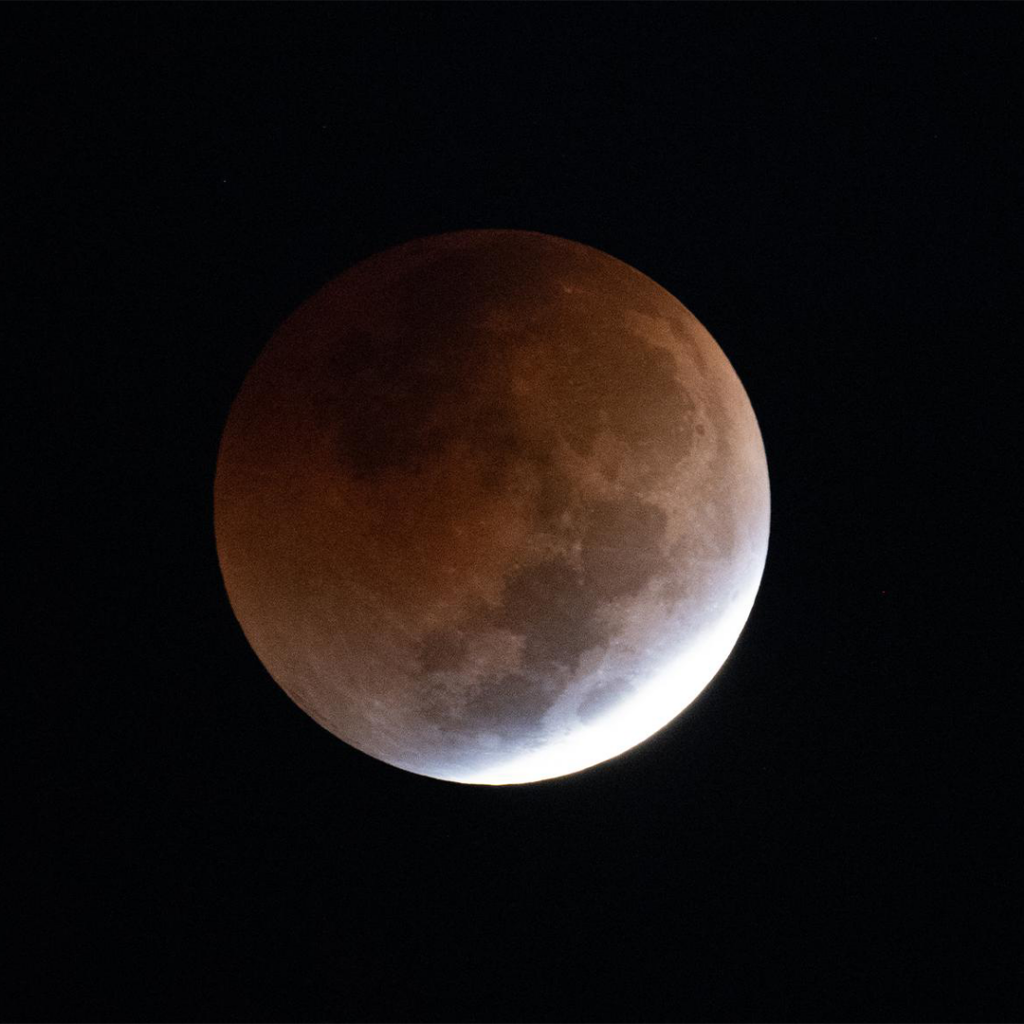
What causes a lunar eclipse? Sunlight falls on our Earth, and the Earth’s shadow is cast into space behind it—just like when the sunlight falls on you, and your shadow is cast behind you. If the Moon happens to pass through the Earth’s shadow, then we’ll see the Moon appear to darken. We call this a lunar eclipse.
How Eclipses Occur
A lunar eclipse can only happen at the phase known as full Moon, when the arrangement in space is a line between the Sun, Earth, and Moon when the Moon is opposite the Sun in our sky. While a full Moon happens every time the Moon orbits the Earth—12 or 13 times each calendar year—we don’t get a lunar eclipse at each full Moon phase. Why? The Moon’s orbit with respect to the Earth is tilted a bit. Because of this tilt, usually the Moon passes a bit above or below the Earth’s shadow at full Moon. When the lineup is exactly right and the Moon’s orbit intersects the Earth’s shadow, the Moon passes through the shadow, and we see the Moon turn brown, red, orange, or gray.
Lunar eclipses can be penumbral, partial, or total, depending on how much of the Moon passes through the lighter outer part of Earth’s shadow or the darker inner part of Earth’s shadow. If the Moon passes through the lighter shadow area—known as the penumbra—this is a penumbral lunar eclipse. If the Moon only passes through part of the darkest shadow area—known as the umbra—this is a partial lunar eclipse. If the Moon passes completely into the darkest shadow area of the Earth’s shadow, this is a total lunar eclipse.
Don’t have a telescope at home? Observe astronomical events virtually with the Adler’s astronomy educators. We host regular episodes of Sky Observers Hangout, so be sure to subscribe to our YouTube channel for updates.
Solar Eclipses Explained
When the Moon’s orbit is aligned just right for a lunar eclipse, it also means it’s aligned just right for a solar eclipse. A lunar eclipse always occurs about two weeks before or two weeks after a solar eclipse. The same parts of Earth don’t necessarily get to see both parts of the lunar-solar eclipse set.
How Do Moon Phases Affect Solar Eclipses?
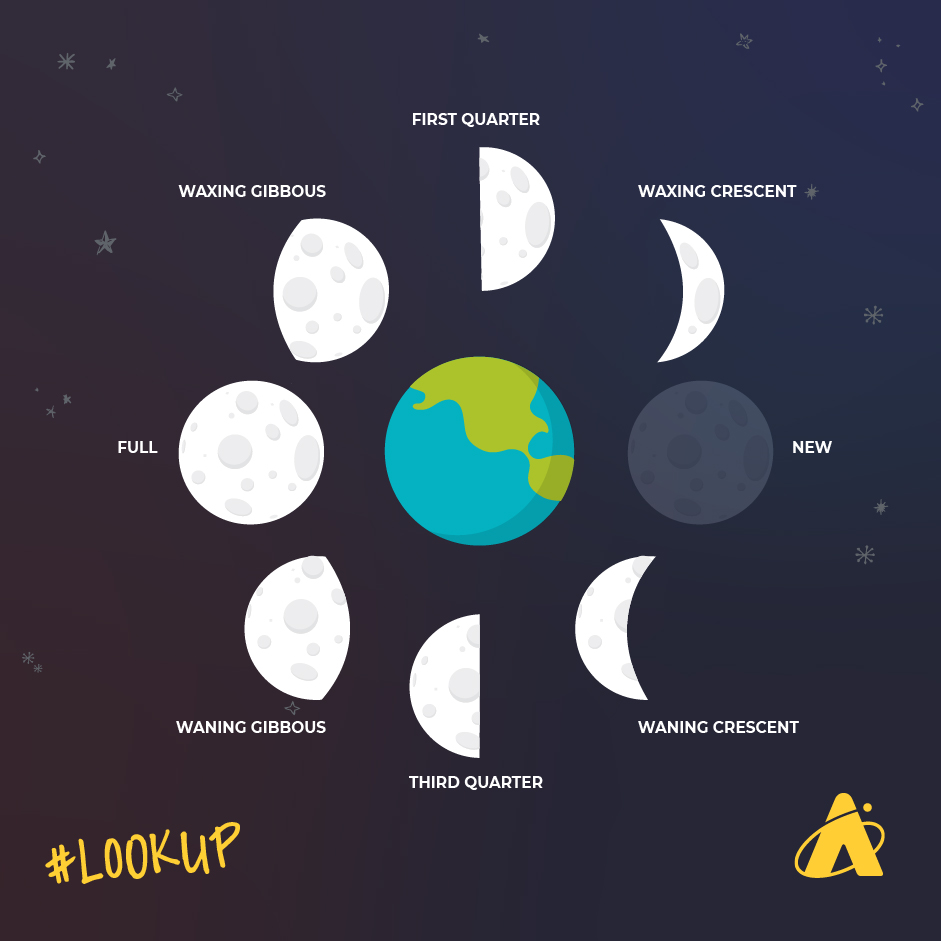
A solar eclipse can only happen at the phase known as new Moon, when the arrangement in space is a line between the Sun, Moon, and Earth. When the lineup is exactly right and the Moon’s orbit intersects the Sun’s position in our sky, the Moon partly or totally covers the Sun.
Solar eclipses can be partial or total, depending on whether the Moon covers part or all of the Sun. If the Moon is close enough to Earth in its oval-shaped orbit, it will be big enough to completely cover the Sun, but when the Moon is farther from the Earth, the size it appears in the sky is not large enough to cover the Sun. When the Moon is too far from Earth to cover the Sun completely, we call this an annular eclipse. The word annular comes from the Latin word annulus, which means ring, referring to the ring of Sun that is left around the Moon during this type of eclipse.
You will always need proper solar viewing glasses to safely view the Sun. Do not look directly at the Sun without certified solar eye protection. If you have glasses or viewers left over from a previous solar eclipse, only use them if you have stored them away from light, heat, and humidity and you are certain they do not have any pinholes or punctures. If you aren’t sure if your viewers are safe, when in doubt, buy new ones.
Learn More About Sky Observing From Our Astronomy Educators
Watch exclusive live episodes of Sky Observers Hangout! With our astronomy educators you’ll learn how to observe upcoming cosmic happenings, enhance your astrophotography skills, and see celestial objects through a telescope virtually including all types of eclipses. If you are not able to tune in live with us, you can watch recaps of the episodes on our YouTube channel.
Tour the night sky with Skywatch Wednesday host Nick who uses cutting-edge visualizations, NASA images, and astrophotography to show you what you can see in the night sky.
Need some space in your inbox? Sign up for our emails to get the latest breaking space news, Adler happenings, and updates for upcoming live Sky Observer Hangout episodes.
Adler Skywatch: March 2025
Header Image:The May 15, 2022 lunar eclipse at totality. The full moon appears to be a dark red-orange as the Earth’s shadow covers it. Image credit: Adler Planetarium
Daylight Saving time, a total lunar eclipse, and the beginning of spring in the northern hemisphere all occur this month, March 2025.
Get Ready For The Total Lunar Eclipse
The Moon gets totally eclipsed this month, beginning late at night on March 13 and into early morning on March 14. In the western part of the United States, the eclipse takes place primarily before midnight on March 13. In the eastern United States, much of the eclipse occurs after midnight on March 14. But no matter where you are located, eclipse totality runs for just over an hour.
How To See The Total Lunar Eclipse In Chicago
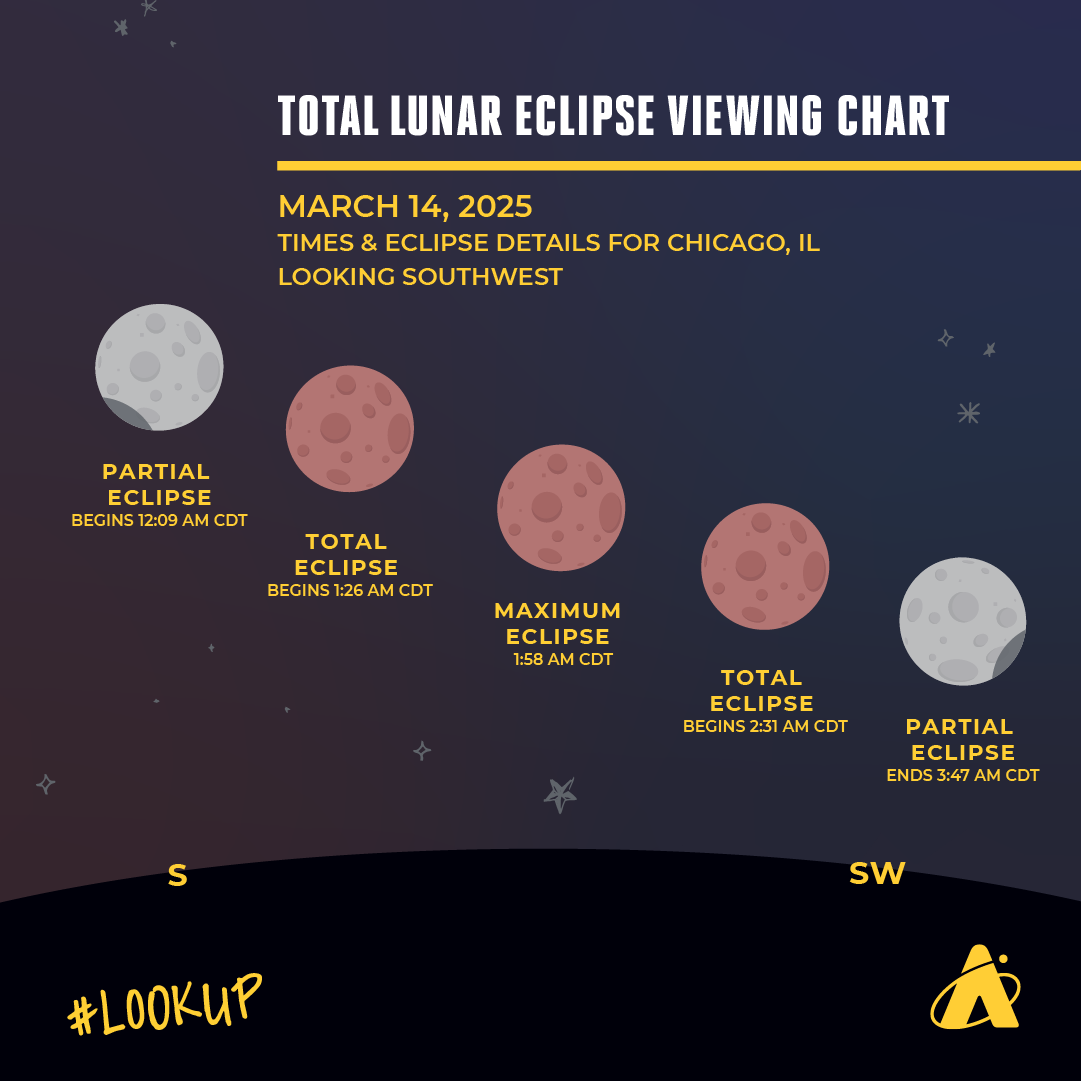
In the Chicago area, the Moon starts its entry into the Earth’s lighter outer shadow, called the penumbra, at 10:57 pm Central Daylight Time on March 13. The more noticeable darkening of the Moon occurs when the Moon begins its entry into the Earth’s darker inner shadow, called the umbra, starting at 12:09 am on March 14. By 1:26 am, the full Moon is totally within the umbral shadow, reaching totality at 1:58 am.
Totality ends in the Chicago area at 2:31 am, and the partial eclipse ends at 3:47 am when the Moon exits the umbral shadow. The Moon exits the Earth’s penumbral shadow at 5:00 am, ending the eclipse. The Moon generally does not entirely disappear during totality, depending upon atmospheric conditions at the time of the eclipse. Often it takes on a rusty, deep-red color, giving a lunar eclipse the common name of blood Moon.
Interested in learning more about lunar eclipses? Head to our blog Everything You Need To Know To See The Next Lunar Eclipse On March 13–14, 2025.
Spring Begins

The vernal equinox, which marks the first day of spring, occurs at 4:01 am CDT on March 20. On the equinox, the Sun is directly in line with Earth’s equator, rising and setting due east and west, making daylight and nighttime roughly equally long on this date. Each day will have more daylight time until the summer solstice, which this year falls on June 20.
Daylight Saving Time Begins
Daylight Saving time begins on March 9 in 2025. Don’t forget to move your clocks forward one hour at 2:00 am! Daylight Saving time lasts until November 2 this year.
What Planets Are Visible In March 2025
The first couple weeks of the month, the brightest planet, Venus, is dazzling and low in the western skies during early-evening twilight. By mid-month, it gets too close to the setting Sun to be readily visible. But don’t worry—Venus reappears at the end of the month, shortly before sunrise, low in the east.
For the first half of the month, Mercury appears not far from Venus, near the western horizon. Though not as bright as Venus, Mercury is brighter than zero magnitude the first week of the month. On March 1, a two-day-old waxing crescent Moon appears between Venus and Mercury. Each evening, Mercury gets slightly dimmer. It appears to get closer to Venus until March 13. By this time Mercury is at about first-magnitude and becomes difficult to view in the setting Sun’s glare.
The bright planet Jupiter pops into view, high in the southwestern skies, during evening twilight. Like last month, it appears near the “V”-shaped asterism in the constellation Taurus. At brighter than minus-two magnitude, Jupiter is brighter than even the brightest stars in the night sky! It’s low in the west-northwest skies around midnight.
Mars also appears during evening twilight this month, high in the southeastern skies. Unlike Jupiter or Venus, which are notably bright in the night sky, Mars varies in brightness, as its distance from the Earth changes considerably over the course of weeks and months. It begins the month at brighter than zero magnitude, which is noticeably brighter than the nearby twin stars, Pollux and Castor, of the Gemini constellation. Mars gets slightly dimmer as each night passes and Earth gradually moves farther from the red planet. By the end of the month, the planet is about +0.44 magnitude—which is still brighter than Pollux or Castor. But by the end of next month, it dims to about first-magnitude; so you may want to look out for Mars now, while it is noticeably brighter than the stars around it.
The night of March 8 and early-morning darkness of March 9, Mars is near a waxing gibbous Moon. Mars sets in the west-northwest before the start of morning twilight in March.
This month the planet Saturn appears so close to the Sun in the sky that it will be difficult, if not impossible, to see.
March 2025 Moon Phases
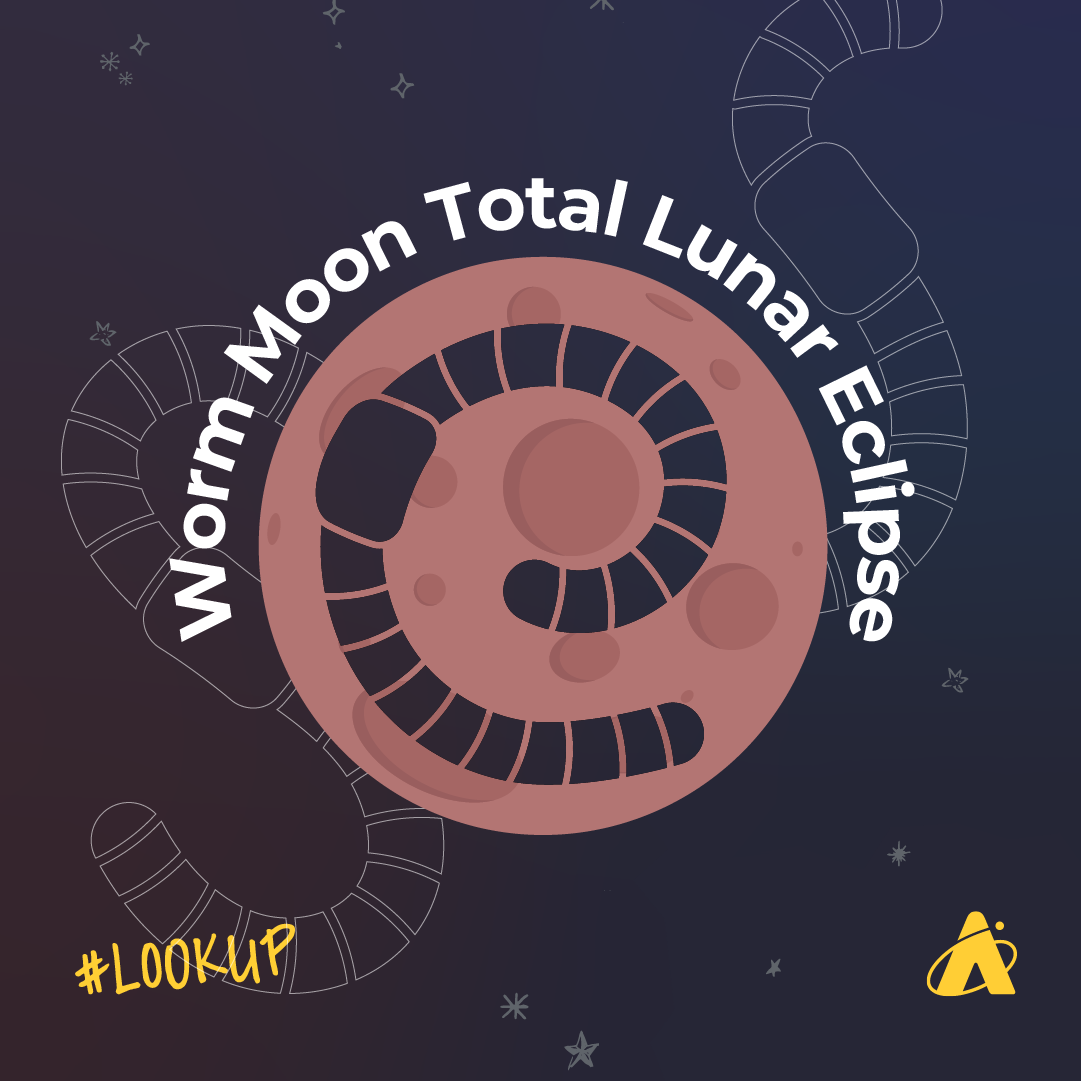
First Quarter Moon: March 6
Full Moon: March 14, nicknamed the worm Moon
Last Quarter Moon: March 22
New Moon: March 29
Please note: these descriptions are for the Chicago area, using Central time.
Subscribe To Skywatch Wednesday This March
Tour the sky with the Adler Planetarium’s Theaters Manager, Nick, in Skywatch Wednesday. Nick uses cutting edge visualizations, NASA images, and astrophotography to show you what you can see in the night sky throughout the year.
Check out Nick’s latest episode for your guide to spring stargazing and the March lunar eclipse!
Learn From Our Astronomy Educators
Watch recaps of Sky Observers Hangout livestreams this March! Learn how to observe upcoming cosmic happenings, enhance your astrophotography skills, and see celestial objects through a telescope virtually with our astronomy educators.
In the latest episode, Michelle and Hunter observe the planetary parade of 2025. See Venus, Mars, Jupiter, Saturn, Neptune, and Uranus through the 24” telescope in the Doane Observatory!
Everything You Need To Know To See The Next Lunar Eclipse On March 13–14, 2025
Header Image: The Moon is seen during a total lunar eclipse, Tuesday, November 8, 2022, at NASA’s Kennedy Space Center in Florida. Image Credit: NASA/Joel Kowsky
Get ready for the next total lunar eclipse! On the evening of March 13, 2025 starting at 10:57 pm CDT, the full Moon—known as the Worm Moon—will begin to pass into the Earth’s shadow, creating a total lunar eclipse.
Here’s everything you need to know to see the March lunar eclipse as it passes over all of North America and South America!
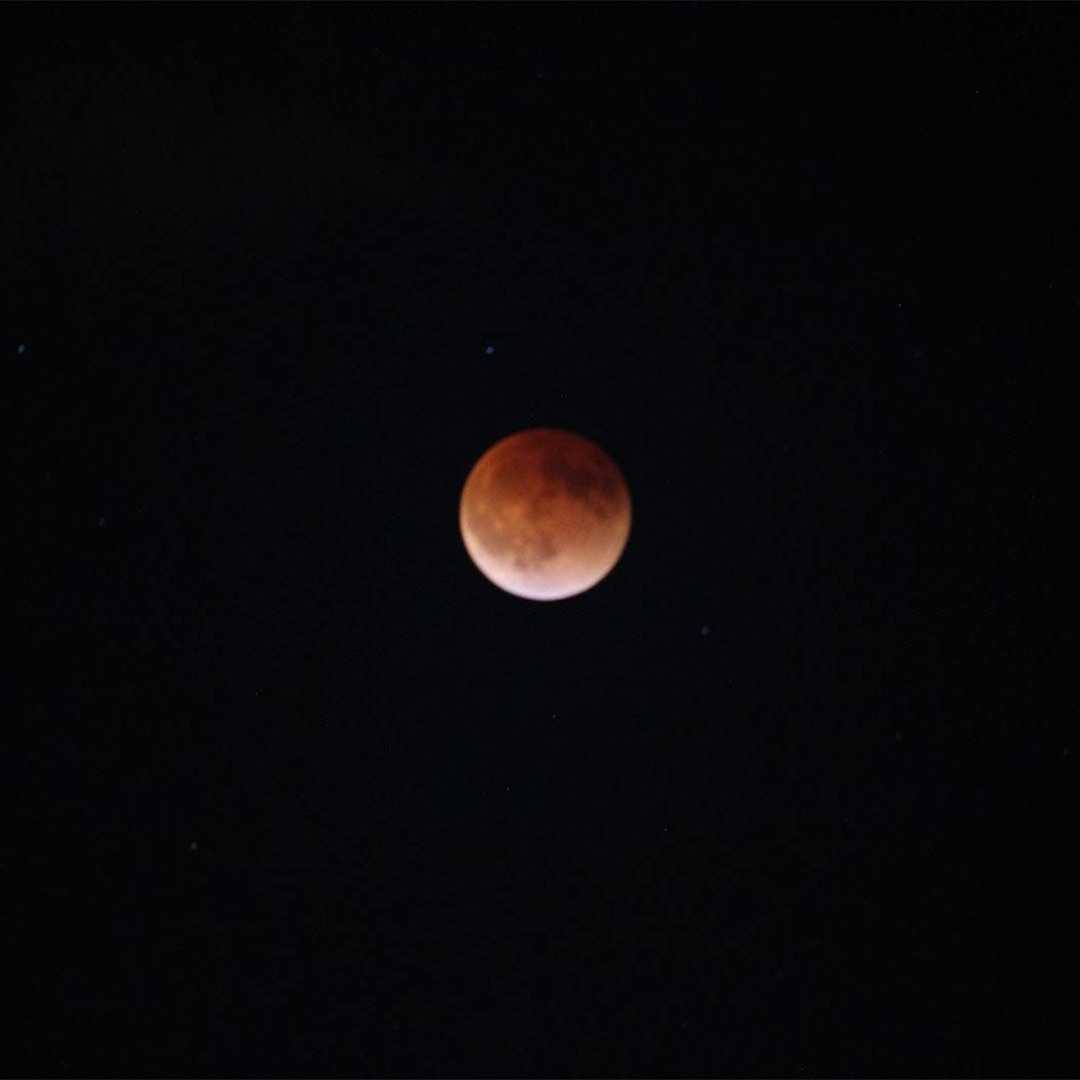
Lunar Eclipses Explained
When the Sun’s light falls on our planet, the Earth blocks some of it and casts a shadow into space. This is just like when you’re standing in the Sun—a shadow is cast because YOU are blocking some of the Sun’s light! When the Moon’s orbit intersects with the Earth’s shadow, the Moon passes through the shadow and creates a lunar eclipse. A lunar eclipse can only happen when the Moon is at the full Moon lunar phase.
Why don’t we get a lunar eclipse at every full Moon? The Moon’s orbit doesn’t always intersect Earth’s shadow. On average, this only happens once or twice a year, so lunar eclipses are somewhat rare. Additionally, depending on your location, you may not see a lunar eclipse occur. If your spot on the Earth is not facing the Moon while the eclipse is happening, you may not see the eclipse at all. This makes spotting a lunar eclipse even more special!
Different Types Of Lunar Eclipses
A penumbral lunar eclipse occurs when the Moon passes through the lighter, outer part of Earth’s shadow, called the penumbra. When the Moon is in this part of the shadow, it may appear a bit more tan in color, but it can sometimes be hard to notice any color change at all.
A partial lunar eclipse occurs when only some of the Moon passes into the darker, inner area of Earth’s shadow, called the umbra. At this point, the Moon looks like it has a bite taken out of it, and that bite grows progressively larger as the Moon passes more and more into the dark shadow.
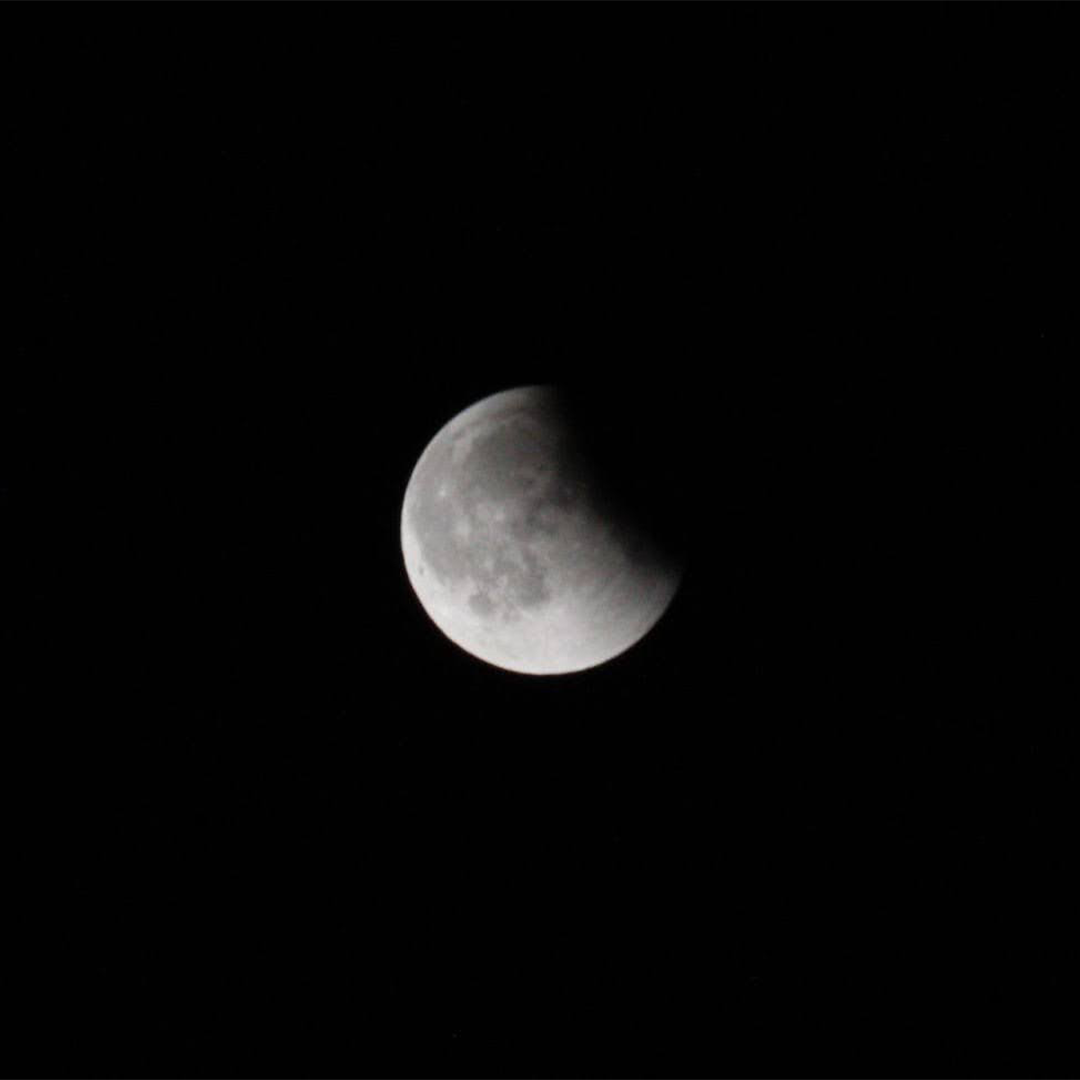
A total lunar eclipse occurs when the Moon fully passes into the Earth’s umbra, the darkest central part of its shadow. Once totality begins, the Moon can appear reddish.
Why Does The Moon Look Red During A Total Lunar Eclipse?
The red color of the Moon during totality is due to sunlight passing through the atmosphere all around the edge of the Earth. Our atmosphere scatters away the bluer rays of the Sun’s light, and the redder wavelengths of light pass through into the Earth’s shadow. You can also see this effect right before sunset: at that moment, sunlight is passing through a lot of air, scattering the blue wavelengths and leaving the redder wavelengths. Think of a lunar eclipse as showing you the color of the collective sunrises and sunsets happening around the entire edge of the Earth at that exact moment. Pretty cool, right?
The color of the Moon during totality might be different from one lunar eclipse to the next. This depends on whether the air the sunlight is passing through is dusty, clear, or cloudy. Sometimes during a total lunar eclipse, the Moon might appear light or dark red, orange, or even dark gray. That’s part of the fun of total lunar eclipses—you don’t know exactly what the color of the Moon will be until the eclipse happens! The lunar eclipses in November 2021 and November 2022 were both a dark, brick red in color. We’ll see what we get in the March 2025 lunar eclipse!
What Is A Blood Moon?
Blood Moon is an informal term used to refer to a total lunar eclipse, but it is not technically an astronomical or scientific term. The phrase’s usage has grown in popularity, and these days, blood Moon and lunar eclipse are used interchangeably. People like using the phrase blood Moon because the Moon might appear red or orange during the totality phase of a lunar eclipse.
Solar And Lunar Eclipses Come In Pairs
Solar eclipses and lunar eclipses are extremely intertwined—one does not exist without the other. If the Moon’s orbit is lined up for a lunar eclipse, it is also lined up for a partial or total solar eclipse, either two weeks before or after the lunar eclipse. However, both eclipses may not be visible to the same parts of Earth, and both eclipses may not be total. The type of lunar eclipse will depend on which part of the Earth’s shadow the Moon encounters, and the type of solar eclipse will depend on how much of the Sun is covered as seen from the Earth.
The solar eclipse that corresponds with the March lunar eclipse arrives on March 29, but won’t be visible here in Chicago. To learn more about the March solar eclipse, head to Time and Date’s page on the March 29, 2025 partial solar eclipse.
To dive more into the explanation of both solar and lunar eclipse, check out our blog Solar Eclipses And Lunar Eclipses Explained.
Can I See The Total Lunar Eclipse From My Location?
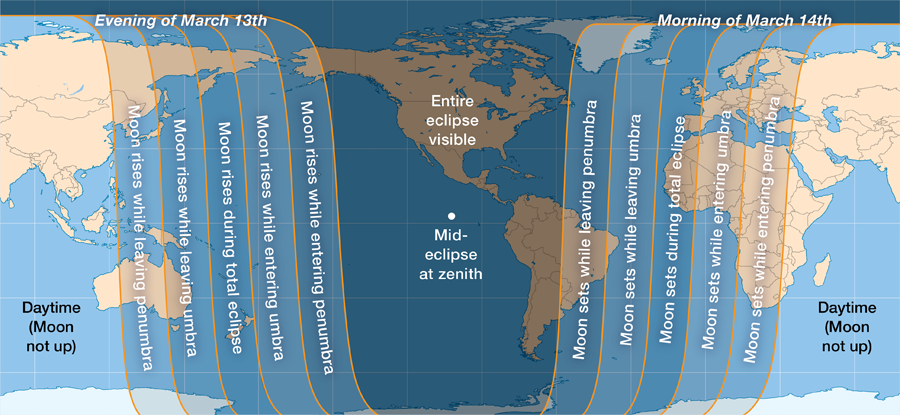
The March lunar eclipse will be visible for all of the USA, Canada, Mexico, Central America, and South America, as long as clouds are not blocking your view of the Moon. A few areas of North and South America, Africa, Europe, eastern Asia, and Australia will only see part of the eclipse at moonrise or moonset, depending on the viewer’s specific location and where the Moon is in the sky as the eclipse is occurring.
To see the lunar eclipse visibility map and the eclipse timing for your area, check out Time and Date’s total lunar eclipse interactive map.
March Lunar Eclipse Timeline For The Central Time Zone
Penumbral Lunar Eclipse Starts: 10:57 pm (March 13)
Partial Lunar Eclipse Starts: 12:09 am (March 14)
Totality Starts: 1:26 am
Totality Ends: 2:31 am
Partial Lunar Eclipse Ends: 3:47 am
Penumbral Lunar Eclipse Ends: 5:00 am
All times listed are in Central Daylight time.
Tips And Tricks For Seeing The Total Lunar Eclipse In March 2025
- Check the weather beforehand and dress appropriately. Lunar eclipses usually take several hours from start to finish.
- Double check the time of each lunar eclipse phase in your time zone leading up to totality. Depending on where you are, the eclipse might start for you on the evening of March 13 or the early morning of March 14. That timing depends on your time zone at the moment when the Moon is passing through the Earth’s shadow.
- Find a spot where you can see the Moon that is not obstructed by tall buildings and trees.
- Don’t stress about needing a telescope or binoculars—you don’t need any special equipment to see a lunar eclipse. If you can see the Moon with just your eyes at any other time, you can see a darker version of the Moon with just your eyes.
Watch The Eclipse Live With Our Astronomy Educators
Watch exclusive live episodes of Sky Observers Hangout throughout the year! Learn how to observe upcoming cosmic happenings, enhance your astrophotography skills and see celestial objects through a telescope virtually with our astronomy educators.
In their next episode, our astronomy educators will talk about what happens during a lunar eclipse and, weather permitting, watch live as the Moon passes through the Earth’s shadow. They’ll explain how lunar eclipses happen, answer all your most pressing astronomical questions, and most importantly offer some tips for you to observe the eclipse yourself. Streamed live from the campus of Southern Illinois University Carbondale, join us for an out-of-this-world eclipse!
